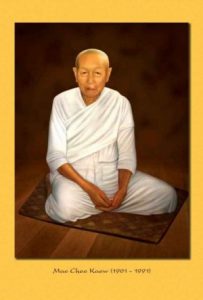
“If you neglect to cultivate your inherent mindfulness and wisdom, striving only half-heartedly, the obstacles in your path will multiply until they block all sight of the way, leaving the end of the road forever in darkness.”
Mae Chee Kaew (1901 – 1991)
There are many great monks in the Thai Forest tradition, some of them widely regarded as arahants. But the story of this woman is by far not as well known as those of the monks! And yet it is worth telling—a story about a difficult struggle and great achievements.
Two years ago Barbara Yen published this article on Gotami Vihara Society Malaysia’s website about the life and spiritual practise of Mae Chee Kaew in 20th century Thailand.
There is also a book telling her story, published by Forest Dhamma Monastery. (Select “Mae Chee Kaew” in the list at the left; you can download the book in different formats.)
In fact, there is a somewhat ambiguous background to this book: Part of the reason why it has been published was to show that Bhikkhunī ordination is not necessary for a woman to become an arahant.
Sure, Kaew was “only” a Mae Chee, and she practised well and achieved a lot; and reading her story is indeed very inspiring. But is this really a reason to deny full ordination to women?
First: There are not many Mae Chees who are as fortunate as Mae Chee Kaew to find sufficiently supportive conditions for their practise. Unlike monks, Mae Chees in Thailand have to live on their own funds and don’t receive any public support. If they don’t have enough money on their own they need to find a private sponsor. And in many places they are expected to cook and clean for the monks and don’t always have the opportunity to study and practise themselves.
Bhikkhu Anālayo describes this situation in his article “The Four Assemblies and Theravāda Buddhism”:
“Comparable nun traditions in Myanmar are the thila shins and in Sri Lanka the dasasil mātās. In spite of some local differences, these share with the mae chis the basic problem of being situated in an ambivalent position between laity and monastics. There can be little doubt that lack of recognition of their monastic status continues to be a problem. This in turn makes it rather difficult for them to live up to the expectation voiced in the Mahāparinibbāna-sutta as cited earlier.” (This is: “This passage makes it unmistakably clear that an essential foundation for the Buddha’s mission of teaching the Dharma was that bhikkhus as well as bhikkhunīs, and male as well as female lay disciples, are wise and well-trained, and that they are also self-confident.”)
And second: The question whether there are or aren’t Bhikkhunīs in a country like Thailand, or anywhere in the world, also has a huge relevance for other women. This became even more obvious to me when hearing a story Ayya Tathaaloka related in a talk she recently gave in Sri Lanka, mentioning Mae Chee Kaew without mentioning her name:
“The first time that I was there [in Thailand], for the vast majority of monastics, Venerable Bhikkhus, and also for the laypeople, Upāsakas and Upāsikas, they had never seen or met a Bhikkhunī before. … so many people at the village level who had never seen a Bhikkhunī before in their lives, and so many women who had never had the chance to offer something personally by hand to a fully ordained member of the Buddha’s Sangha. In Thai society to offer something directly by hand is considered to be very meritorious, but no woman is allowed to do that to a Bhikkhu. But they understood quite quickly: With a Bhikkhunī they can do that. So there were some women both young and old who then came even with tears streaming down their faces for the first opportunity to be able to offer something by hand and feel that it was a fully legitimate offering. … So you might say: But Thailand has many white robed nuns—why would people feel like that? But for people it made a big difference. Sometimes in fact even some of the nuns are so dedicated and virtuous, even … the late most Venerable Luang Por Maha Boowa … said one of his disciples had become a Bhikkhunī arahant, robed in white though. People even though they built a stupa, still could not feel, even she became an arahant, still could not feel that she was completely legitimate. Because of not being able to be fully ordained or fully accepted—upasampada means to be fully accepted into the Sangha. So this is a bit of a distortion that then existed in Theravāda Buddhism. I think for the arahant we should be able to wholeheartedly pay our full respect without any doubt in our mind.”
And here is another aspect the presence of Bhikkhunīs in society can have, mentioned by Bhante Sujato in this thread on SuttaCentral’s discussion forum “Discuss & Discover”:
“There is a record of a very frank conversation among senior monks in Bangkok regarding ordination, and this is one of the major issues. The problem they expressed is that, given that there are estimated to be twice as many sex workers as monks in Thailand, if bhikkhunī ordination were to be available, these women and girls would soon find they had other options, and would join the Sangha in large numbers.
This would mean that there would likely be soon more nuns than monks in Thailand; and they pointed a worrying finger at the situation here in Taiwan as an example of what can happen when things get out of hand, with four times as many nuns as monks.
The notion that it would be a good thing for women to have options other than sex work was not a part of the conversation.”
Enjoy letting yourself be inspired by Mae Chee Kaew’s story, and please don’t forget that in order for Buddhism to be complete, we need the Four Assemblies!
(Sabbamitta)


 Deutsch
Deutsch Français
Français Nederlands
Nederlands